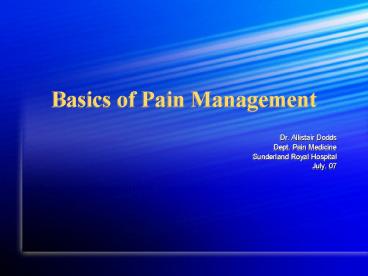Basics of Pain Management - PowerPoint PPT Presentation
1 / 26
Title:
Basics of Pain Management
Description:
... pain /- non opioid /- adjuvant. Step 2: opioid for mild to moderate pain /- non opioid /- adjuvant ... Step 1: non opioid /- adjuvant. The '5' phrases ... – PowerPoint PPT presentation
Number of Views:85
Avg rating:3.0/5.0
Title: Basics of Pain Management
1
Basics of Pain Management
- Dr. Allistair Dodds
- Dept. Pain Medicine
- Sunderland Royal Hospital
- July. 07
2
3 Types of Pain (temporal)
- Acute
- Chronic
- Cancer
3
Types of Pain (physiological)
- A? fibres
- C fibres
- Sensitisation
4
WHO should take the place of Descartes?
5
WHO ladder
- Cancer pain
- Step 3 opioid for moderate to severe pain /-
non opioid /- adjuvant - Step 2 opioid for mild to moderate pain /- non
opioid /- adjuvant - Step 1 non opioid /- adjuvant
6
The 5 phrases
- By mouth
- By the clock
- By the ladder
- For the individual
- Attention to detail
7
The 5 phrases
- By mouth
- For the individual
- Attention to detail
8
Science and Sociology
- Drugs targeted at the lesion
- Analgesia targeted to the patients requirements
9
Cyclo-oxygenase
- COX converts arachidonic acid to prostaglandin H2
a precursor of the inflammatory prostaglandins. - Type 1 - constitutive maintains the function of
gut, kidneys, platelets etc. - Type 2 inducible, expressed during the
inflammatory response
10
Paracetamol
- Simple analgesic
- Anti-inflammatory - periphery
- Anti-pyretic - hypothalamus
11
Pharmacology
- Tablet, effervescent, syrup, suppository, iv
infusion - NNT 3.8 (3.4-4.4) 50 pain relief acute pain
- Henry McQuay Andrew Moore An evidence based
resource for pain relief Oxford Medical
Publications 1998
12
Non steroidal anti inflammatory drugs (NSAIDs)
- Simple analgesic
- Anti-inflammatory - periphery
- Anti-pyretic hypothalamus
13
Efficacy
- All common NSAIDs have an NNT of
- 2.3 (2.0-2.7) for 50 acute pain relief
- No difference between the cox 2 specific
(rofecoxib), selective (naproxen) and
indiscriminate (ibuprofen) drugs. - Henry McQuay Andrew Moore An evidence based
resource for pain relief Oxford Medical
Publications 1998
14
Side effects
- Can be partially predicted by the interaction of
NSAIDs and COX 1. - Gastric ulceration
- Heart failure deteriorates
- Renal failure deteriorates
- Platelet dysfunction
15
Side effects newer drugs
- Newer Cox 2 specific drugs cause less gastric and
platelet effects but just as dangerous in renal
and heart failure. - The reduction in dyspepsia sometimes improves
compliance.
16
Opioids
- Bind to mu (µ) receptors in spinal cord and brain
inhibiting the transmission of electrical
activity that signals pain. - Grouped according to potency
- (weak strong)
17
Weak opiods
- Codeine pro-drug not metabolised to active
agent (morphine) in 17-34 of patients. - Dihydrocodeine pro-drug, again a wide variation
in patient response. - Tramadol active drug.
18
Efficacy
- NNTs
- Tramadol 100mg 4.8 (3.8 - 6.1)
- Dihydrocodeine 30mg 8.1 (4.1 540)
- Codeine 60mg 16.7 (11- 48)
- But
- paracetamol 1g codeine 60mg 2.2 (1.7 2.9)
- Henry McQuay Andrew Moore An evidence based
resource for pain relief Oxford Medical
Publications 1998
19
Strong opiods
- No requirement for metabolism
- 50 oral bioavailability
- Fentanyl patch 25 - approx 90mg oral morphine per
day
20
Morphine
- Presentation
- Tablets, capsules, solutions , patches,
suppositories, iv injection. - Usually titrated to effect.
21
Side Effects
- Common adverse reactions constipation, nausea
and vomiting, drowsiness, dizziness, headache,
itch, dry mouth,. - Infrequent adverse reactions include
dose-related respiratory depression , confusion,
hallucinations.
22
Chronic Pain
- An alternative evidence based approach.
23
Pain Management Programme
- Given the multi-dimensional nature of
long-standing pain problems, the most effective
approach is to treat through multi-professional
teams. - PMP is a psychologically framed, group based
rehabilitation treatment that utilises the
biopsychosocial model as the philosophical
underpinning to assist people in the further
development of pain self-management.
24
Pain Management Programme
- Programme Structure
- PMP is a 12 session (x3.5 hrs) treatment
delivered over a year - 8 intensive sessions (weekly)
- 4 consolidation sessions over next 10 months (1,
2, 4 and 6 months). - Graduate programme
25
The Treatment Components
- 1. Educational eg. gate-control theory, active
neuro-matrix. - 2. Cognitive Restructuring Skills to modify
unhelpful pain and negative affective state
related cognitions. - 3. Problem Solving Developing solutions to
carry out desired goals. - 4. Coping Skills Training Behavioural
management (baselines, pacing). - 5. Relaxation Assisting people gain increased
control over heightened physiological arousal. - 6. Exposure to Feared Activities Reduction of
avoidance and testing out activities to reverse
de-conditioning.
26
Acessing the Service
- Referal to the Pain clinic.
- Intitail MDT assessment.
- Those wishing to be considered for the PMP
offered an education session about this
treatment. - Patients then offered a short PMP assessment to
determine their therapeutic goals. - Formal assessments are taken of key clinical
parameters (defined from the biopsychosocial
model) that are targeted for active change. - Following the successful completion of these
procedures, patients enter the treatment
(structured in a group based format).































